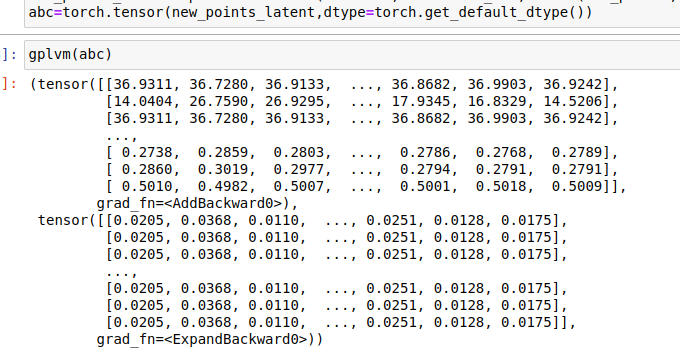Hello there,
I am just starting to use pyro. I am supposed to use GPLVM and predict similar points as of my datasets. I have data of size 78 dimension, following the example given in examples/gplvm.html in pyro I reduced the dimension of data into latent space of dimension 2.
Now I need to predict similar points into latent space and back to 78 dimension. I am stuck here,(prediction of points and back to input dimension) can you please suggest how this is possible?
I feel that you need to do inference using GPLVM again on the new data points (using set_data method). But this time you can skip optimizing the GP parameters.
@fehiepsi thank you for your reply, and sorry for responding late!
I am absolute beginner and hope you can further help me as I was not clear on what you mean.
what I did till now is made a kernel using kernels.RBF, initiated inducing points and used this:
gplvm=gp.models.SparseGPRegression(), guided using this gplvm.X=pyro.nn.PyroSample(dist.Normal(X_init,0.1).to_event()) gplvm.autoguide("X",dist.Normal) and fetched mean and deviation using mean = gplvm.X_loc.detach().numpy() and std_dev=gplvm.X_scale.detach().numpy() respectively. Further, used this to predict new points in latent space new_points_latent=np.random.normal(loc=mean, scale=std_dev, size=(new_points, mean.shape[1])).
Now I am confused, if I am on correct way or not, if yes how can I proceed forward and if not how can I correct myself. Sorry if I am too specific.
Sorry, I misunderstood your question. I thought you wanted to get latent values corresponding to “new” similar points in your dataset.
I think it’s better to use VariationalSparseGP instead and after fitting, you can do
gplvm(new_points_latent)
I feel that you can also do
gplvm.model()
so that you don’t have to fetch mean, std_dev and create new_points_latent. Let me know if it does not work.
thankyou! will try it.
I tried it, I didn’t do gplvm.model() but the same mean and std. deviation method, I used gplvm(new_points_latent)
ofc, converted new_points_latent into tensor using torch.tensor, but got tuple of length 2, as it’s output and am not sure what did it return.
Couldn’t find anything such in documentation too!

Hi @acharyafutures , you can find the documentation here Gaussian Processes — Pyro documentation
Thankyou for your quick response, I had a look at it, but am not sure what is the tuple returned by it.
Sorry, if I am too naive.
GP(X) returns a Normal/Multinomial distribution for y. The returned value is mean and variance/covariance of that distribution. You can consider the mean as the prediction y_pred. If you want to incorporate the uncertainty, you can use the variance and draw samples from that distribution.
Thankyou @fehiepsi , I guess I am clear now!
Hello @fehiepsi, thankyou for your help earlier, I did so and was going pretty well but I am confused now as I had new_points_latent=np.random.normal(loc=mean, scale=std_dev, size=(new_points, 10))
used this line to draw samples but the problem is I need to have new_points= len(mean) all the time .How can I predict more points?